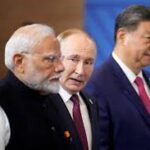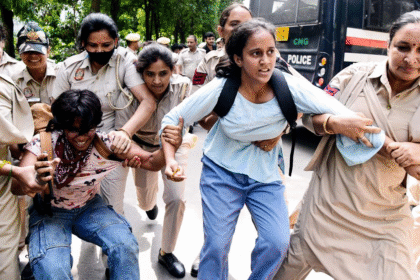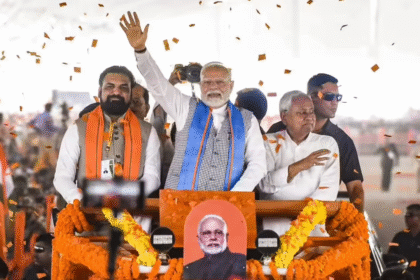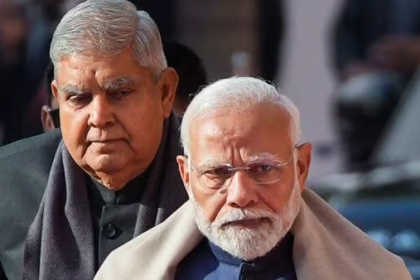Rahul Gandhi’s Bihar Yatra: A Powerful Quest to Revive India’s Soul
In the monsoon-soaked plains of Bihar, where the Ganges murmurs timeless tales of struggle and resilience, a modern epic unfolds – a clash between two titans: one, a crusader driven by zeal to restore the ideals that forged India as a democratic republic rooted in justice and ‘sarva dharma sambhav’ (equal respect for all religions), and the other, accused of deploying cunning stratagems to dismantle these very principles.
The Voter Adhikar Yatra, launched by Rahul Gandhi on August 17, 2025, in Sasaram, Bihar, has traversed three-quarters of the state, spanning the north and south banks of the Ganga, drawing a stark battle line between, on one hand, the scion of the Nehru-Gandhi lineage, and on the other, Prime Minister Narendra Modi, a former Rashtriya Swayamsevak Sangh pracharak.
This is not merely a contest for the INDIA bloc to supplant Nitish Kumar’s NDA in Bihar or for Rahul Gandhi to challenge Modi’s premiership. It is a profound struggle to preserve the “Idea of India” – inclusive, embracing diverse thoughts and actions, anchored in fairness – against what critics describe as a ruthless machinery bent on erasing the legacy shaped by freedom fighters who resisted British rule, and the saint-poets, Sufi folklorists and bards who wove verses of love, harmony and coexistence.
Riding a motorcycle with his sister Priyanka Gandhi or Rashtriya Janata Dal leader Tejashwi Yadav by his side, or meeting a former Agniveer maimed in battle and discarded without compensation, Rahul Gandhi engages with farmers, unemployed youth and impoverished villagers. Clad in his signature white t-shirt, trousers and polo cap, the Congress leader exudes the spirit of a crusader.
From Sasaram, Aurangabad, Lakhisarai, Munger, and Bhagalpur south of the Ganga to Katihar, Purnia, Madhubani, Darbhanga, Muzaffarpur, and Motihari north of the river, his approach remains consistent: spreading love, forging connections, visiting religious shrines to seek divine blessings, and sharing the joys and sorrows of ordinary people.
A poignant example of bridge-building was Rahul’s role in uniting Purnia MP Rajesh Ranjan, alias Pappu Yadav, with Tejashwi Yadav. This reconciliation, beyond strengthening the Mahagathbandhan’s electoral prospects, sparked joy among voters in Seemanchal, a region encompassing Purnia, Katihar, Kishanganj and Araria districts.
With a significant Muslim population, Seemanchal is fertile ground for parties championing secularism, justice, and equality. Yet, vote fragmentation along communal lines has often favoured the BJP and its allies. In the 2024 Lok Sabha polls, secular candidates – Pappu Yadav (Independent) in Purnia, Dr. Javed (Congress) in Kishanganj, and Tariq Anwar (Congress) in Katihar – triumphed, but the BJP secured Araria despite secular voters outnumbering its base, underscoring the impact of vote division.
Stalin’s resonant voice
The Voter Adhikar Yatra thrives on spontaneity, with Rahul Gandhi magnetic disposition despite the Congress party’s weakened state in Bihar. Far from arrogance, he displays humility, sharing space and spotlight with allies like Tejashwi Yadav, CPI(ML)-Liberation’s Dipankar Bhattacharya – a tireless advocate for the marginalised – and Vikassheel Insaan Party chief Mukesh Sahni, an emerging voice for the Mallah (fishermen) community.
A powerful moment was on August 27, 2025, in Muzaffarpur, when Tamil Nadu chief minister M.K. Stalin joined Gandhi on the yatra to protest alleged voter suppression. Speaking in Tamil, Stalin invoked the legacy of Periyar, the Dravidian movement’s icon, to champion unity, justice, and democratic values. His presence symbolised a bridge between India’s north and south, linking the Ganga and Kosi with the Krishna and Kaveri rivers, reinforcing a shared fight for voting rights.
Some second-tier Bihar BJP leaders criticised the Rahul-Stalin alliance, citing alleged mistreatment of Bihar’s migrant workers in Tamil Nadu. Yet, they overlooked the vibrant tapestry of Bihar’s migrants, who journey from Jammu and Kashmir to Tamil Nadu, Gujarat to Assam, building infrastructure and enriching their folklore with multilingual songs and stories. Places like Madras (now Chennai), Kolkata, Guwahati, Surat and Bombay (Mumbai) resonate in their ballads with equal affection, a cultural bridge that merits its own telling. The BJP’s selective outrage ignores this shared heritage, while Rahul’s Yatra continues to weave a narrative of unity and resilience across Bihar’s heartland.
While Prime Minister Narendra Modi had chosen to address a rally in Madhubani in English, following the terrorist attack on tourists in Kashmir earlier in 2025, diverging from his usual Hindi-centric oratory, Tamil Nadu chief minister M.K. Stalin, speaking at the Voter Adhikar Yatra in Muzaffarpur on August 27 chose his native Tamil, weaving a message of love and pride for his language to resonate with Bihar’s diverse populace, fostering a sense of cultural unity.
“Rahul Gandhi is not merely battling Modi; he is fighting to resurrect the soul of India,” remarked a Delhi-based senior academic, who holds a key university administrative post and requested anonymity, fearing reprisal for his candour. “He isn’t chasing power. He is striving to revive the legacy of Mahatma Gandhi, Jawaharlal Nehru, B.R. Ambedkar, Bhagat Singh and Subhas Chandra Bose, alongside saint-poets like Kabir, Nanak, Jayasi, and Raskhan, whose verses sang of love, harmony, and coexistence.”
Instances of Unease
Tensions have surfaced during the Yatra. Rahul Gandhi’s sharp accusation in Motihari on August 28, 2025, where he called Modi a “vote chor” (vote thief), sparked outrage among BJP leaders. He stated: “If I am accusing the prime minister of being a ‘vote chor,’ why is he silent? Why is the prime minister not uttering a single word? Kyuki pradhan mantri vote chor hai aur wo jaanta hai… (Because the prime minister is a vote thief and he knows…)”
The term “vote chor” ignited fierce backlash, with BJP leaders decrying it as derogatory and disrespectful, a narrative amplified by mainstream media. Yet, the same media largely overlooked Modi’s 2013 remarks in Gujarat, where he reportedly called Sonia Gandhi a “Jersey cow” and Rahul her “bachhera” (calf).
This selective outrage underscores a disparity in media scrutiny, with Modi’s comments fading from public discourse, possibly due to the BJP’s robust media management A section of vernacular media highlighted “fissures” in the Mahagathbandhan, citing skirmishes between RJD and Congress cadres over party posters in Motihari.
However, RJD leader Tejashwi Yadav dismissed these as overblown, stating, “Don’t make a mountain out of a molehill. After Stalin, Samajwadi Party leader Akhilesh Yadav will join the Voter Adhikar Yatra. We are united and resolute.” Indeed, Akhilesh Yadav’s planned participation signals the coalition’s growing strength.
Who Is the Real Chanakya?
Modern media often liken cunning leaders to the legendary Chanakya, with Amit Shah frequently dubbed “Modi’s Chanakya” and Nitish Kumar once called Lalu Prasad Yadav’s “Chanakya” in the late 1980s and early 1990s. Such comparisons misrepresent Chanakya’s legacy.
While his historical existence is debated, Chanakya is celebrated as a sage who journeyed from Taxila (Takshashila) (now in Pakistan) to Magadha, challenging the despotic Nanda dynasty. He mentored a low-caste boy, Chandragupta, training him in valour to overthrow the Nandas. Chandragupta’s successor, Ashoka the Great, embraced Buddhism, spreading Gautama Buddha’s teachings of peace, non-violence, love and compassion.
If anyone embodies Chanakya’s spirit today, it is Rahul Gandhi. Through the Voter Adhikar Yatra, he seeks to liberate India from arrogance, despotism and the subjugation of democratic institutions. Like the selfless lovers, Ranjha for Heer, or Brijbhar for Sorthi in Indian folklore, Rahul treads a crusader’s path, not for electoral triumph but to uphold India’s pluralistic ethos.
Whether he succeeds against Modi electorally matters less than his emerging role as a hero in India’s rich folkloric tradition, championing unity and justice.
Also Read: EU Foreign Ministers Divided Over Sanctions on Israel Amid Gaza Crisis








